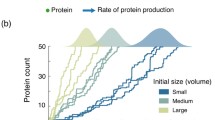Abstract
ROUNDS of DNA replication are initiated in Escherichia coli at different stages in the cell cycle of bacteria growing at different rates1. It is possible to calculate that the initiation of a round of DNA replication always takes place at a time when the cell mass/chromosome origin reaches a particular critical value. In other words, the mass at which initiation takes place is always an integral multiple of a particular mass. This constancy in turn provides an explanation for the increase in size of cells with increase in the rate of growth.
Similar content being viewed by others
References
Cooper, S., and Helmstetter, C. E., J. Mol. Biol., 31, 519 (1968).
Schaechter, M., Maaløe, O., and Kjeldgaard, N. O., J. Gen. Microbiol., 19, 592 (1958).
Donachie, W. D., and Masters, Millicent, in The Cell Cycle: Gene Enzyme Relationships (edit. by Cameron, Whitson and Padilla) (Academic Press, in the press).
Donachie, W. D., J. Gen. Microbiol. (in the press).
Maaløe, O., and Kjelgaard, N. O., Control of Macromolecular Synthesis; a Study of DNA, RNA, and Protein Synthesis in Bacteria (W. A. Benjamin, New York, 1966).
Pritchard, R. H., Abst. Proc. Genet. Soc. (1968).
Author information
Authors and Affiliations
Rights and permissions
About this article
Cite this article
DONACHIE, W. Relationship between Cell Size and Time of Initiation of DNA Replication. Nature 219, 1077–1079 (1968). https://doi.org/10.1038/2191077a0
Received:
Issue Date:
DOI: https://doi.org/10.1038/2191077a0
- Springer Nature Limited
This article is cited by
-
Mid-cell migration of the chromosomal terminus is coupled to origin segregation in Escherichia coli
Nature Communications (2023)
-
Interaction networks of Escherichia coli replication proteins under different bacterial growth conditions
Scientific Data (2023)
-
Robust replication initiation from coupled homeostatic mechanisms
Nature Communications (2022)
-
CcrZ is a pneumococcal spatiotemporal cell cycle regulator that interacts with FtsZ and controls DNA replication by modulating the activity of DnaA
Nature Microbiology (2021)
-
Towards a synthetic cell cycle
Nature Communications (2021)





